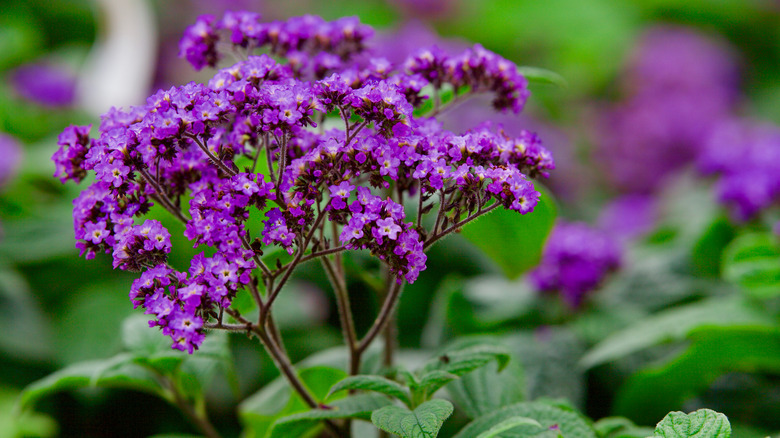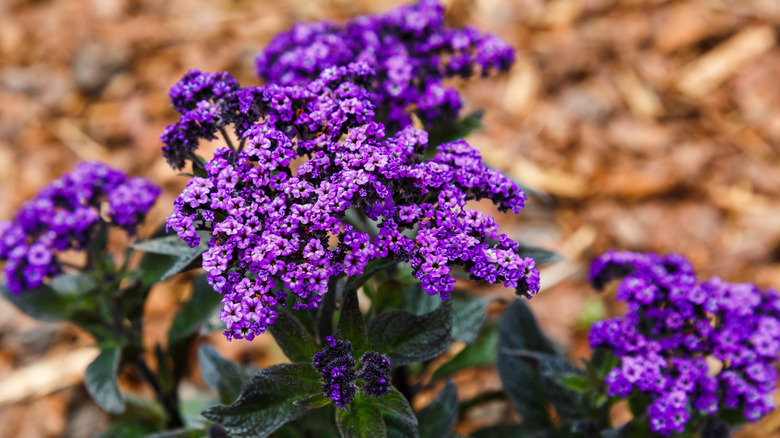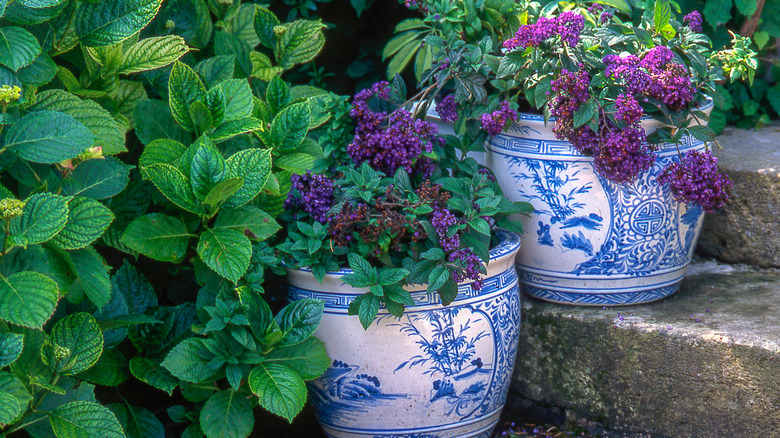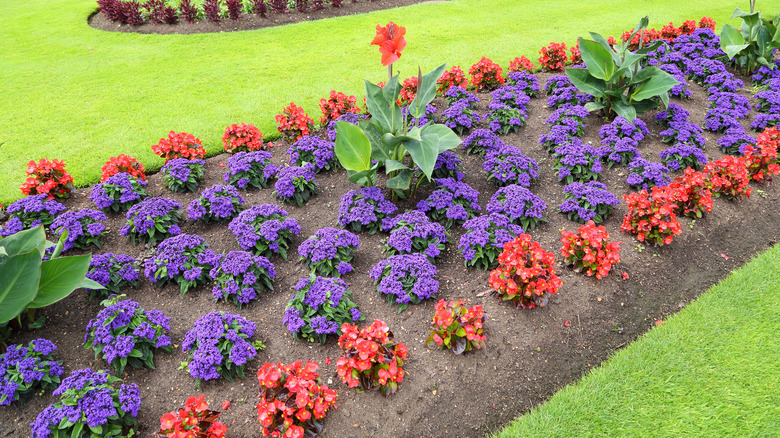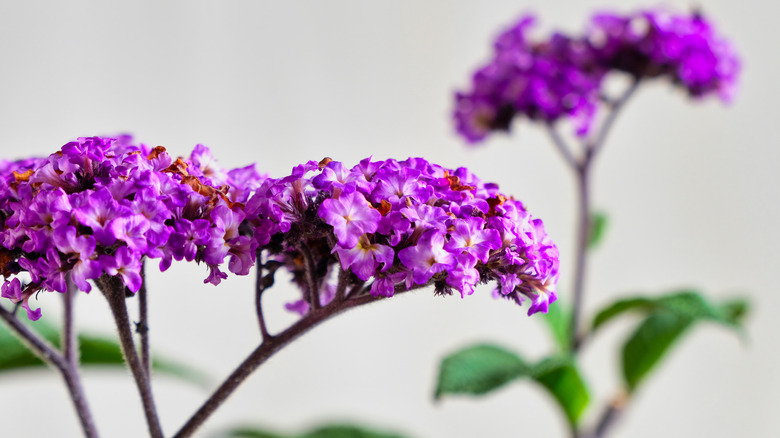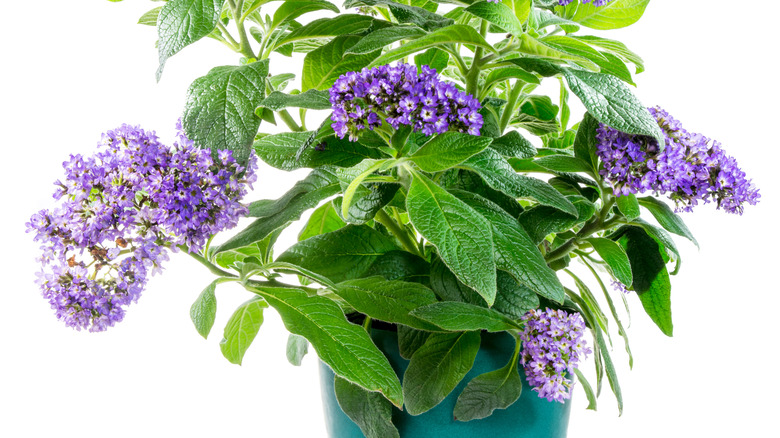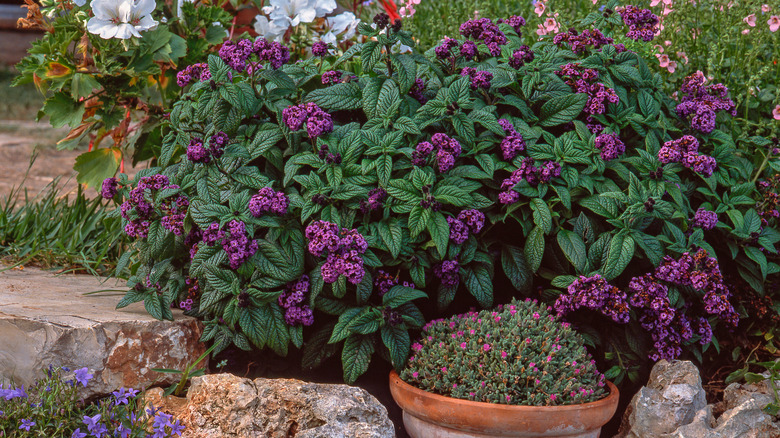Heliotrope: Everything You Should Know Before Planting
Heliotrope is the scientific name for the common cherry pie plant, which is characterized by groups of small, purple flower blossoms that give off the scent of cherries and vanilla, according to Better Homes & Gardens. The flowers burst from the center of the plant and extend above the long, bright-green leaves below, which can reach 3 inches in length. The plant itself grows to a height of between 1 and 3 feet while sprawling to between 1 and two 2 feet wide. The heliotrope is a popular garden and container choice that brings color to any outdoor space.
The heliotrope plant first became popular during the Victorian era when it was adorned by mourning women, chosen for its lovely scent and lavender color, as per Dave's Garden. It was also known as the "flower of love" in the mid-19th century; men would offer the flower to women as a token of their love. Its introduction to Europe dates farther back to the mid-18th century when it was brought over from South America following a scientific expedition; botanist Joseph de Juissieu discovered the sweet-smelling plant in the Peruvian Andes. If you're interested in a plant that smells like cherry pie and will be relatively easy to grow both outdoors and indoors, keep scrolling to learn more about the heliotrope plant and how to care for it.
How to use heliotrope in garden
If you're considering planting a heliotrope in your outdoor space, you will first need to decide if you'd like to place it in a flower bed or separately in a container. Fortunately, this plant does well in both locations. If you choose a container, you can plant the heliotrope among other colorful blooms and keep it on your patio or deck area. Alternatively, raised containers can be a great choice for adding structure to your outdoor landscape by using them to frame or accentuate various areas.
Keep in mind that if you want to plant your heliotrope in the ground, you will need to be mindful of temperatures and seasons. The heliotrope is sensitive to cold and frost and won't survive harsh winter conditions outdoors, according to Gardener's Path. You'll need to bring your plant indoors if you live in a wintery climate. To make this easier, plant your heliotrope in a container or pot from the get go, or be prepared to pull it out of the ground when the first frosts come in the fall.
When planting heliotropes in your garden beds, note that this plant blooms in the summer. If you want to take advantage of an abundantly colorful garden, plant your heliotropes among other flowers and shrubs that bloom in the summer. You may also consider planting them in the middle or front of your garden bed.
How to grow heliotrope
You will likely plant your heliotropes from seeds, according to Gardening Know How. To start, you will need a seed potting mix, which you can purchase from any gardening store. Since the seeds will require four to six weeks to reach maturity, you should start the process in the early spring. Place the seeds individually in small containers filled with the potting soil and water generously. Throughout their growing period, heliotropes will need to stay relatively warm in an area with temperatures between 70 and 75 degrees Fahrenheit. Your seedlings will be ready for their outdoor home when temperatures have warmed up outside past the possibility of frost. It's also important that the soil measures a comfortable 60 degrees Fahrenheit to avoid killing your newly grown heliotropes.
Before planting your seedlings, let them acclimate to the outdoor climate for a week or so by placing them in a shady spot during the day and bringing them back indoors during the night. You'll also need to prepare the soil of your garden by sprinkling it with an organic fertilizer, as per Grow Veg. When it comes to planting in a garden bed, you'll use a trowel to dig holes about 7 inches apart. Then place each seedling in a hole and cover with soil. The same process can be repeated in a container or pot. For the latter option, be careful not to pack heliotrope seedlings too close together as this can make them susceptible to disease.
How to care for heliotrope
With the proper growing conditions, you'll find that keeping your heliotropes happy is relatively easy. For starters, heliotropes should be placed in a location that receives several hours of direct sunlight per day, preferably in the morning hours, as reported by Gardening Know How. Keep in mind that you may need to adjust this depending on the climate of the region in which you live. During particularly hot summer days, your heliotropes may benefit from additional shade. This plant is also heavily dependent on regular watering for proper growth. The soil in which the plant grows should have decent draining properties, but must also hold moisture well to ensure the heliotrope never suffers from thirst. Keep the soil well-watered but never over-saturated.
One important note to keep in mind about heliotropes is that they require plenty of fertilizer throughout their growing season. Offer a generous dose of liquid fertilizer twice a month or so. If you planted your heliotropes in a container, you may need to give them a bit of extra fertilizer compared with garden-bed-grown heliotropes.
As heliotropes won't survive cold winters, you will need to provide adapted care for them throughout this period of the year. Once brought inside, place your heliotrope in a sunny area of your house and make sure it is planted in a nutrient and fertilizer-rich soil. You won't need to water it quite as often until it is returned to the outdoors.
Varieties of heliotrope
There are more than 300 heliotrope species, all hailing from South America, according to The Spruce. While most come in shades of purple and blue, some varieties boast beautiful white flower blooms. One of the most popular varieties is the dwarf marine, which is a smaller version of the heliotrope plant that reaches just over 1 foot in height, per the Garden Lover's Club. It boasts the small clusters of purple flowers that are so characteristic of the heliotrope. The European heliotrope grows white blooms that feature a yellow center and is the hardiest of the heliotrope varieties, often growing wild on the side of major roads. This variety can reach a foot and a half in height and features spiky flowers.
The blue heliotrope's blooms aren't quite blue as its name suggests, featuring a slightly more purple hue. The leaves of this variety are the most unique part, which are covered in small hairs. The tree heliotrope is a mammoth compared to other varieties in the family with heights of between 3 and 12 feet. Its blooms are tiny, bunched, and white in color and its trunk is remarkable for its curved pattern. The leaves of the tree heliotrope are elongated in appearance. One other variety of heliotrope is the salt heliotrope, which stands out from the rest with its later blooming period, typically lasting until November. As the name suggests, this variety also needs a higher concentration of salt in the soil.
Is heliotrope toxic?
Heliotropes are highly toxic to both humans and other animal species, according to George Mason University. While consumption may cause immediate discomfort in the gastrointestinal tract, the effects of ingesting the heliotrope plant are seen over time with significant damage to the liver. Signs of heliotrope poisoning include excessive sleepiness, jaundice, oral ulcers, weight loss, loss of appetite, and a bloated abdomen, as per Paws. The liver damage will eventually lead to death if not treated; however, once significant liver damage has occurred, disease progression is inevitable even with treatment.
The best way to deal with the horrible and fatal effects of ingesting heliotrope plants is to prevent it. With small children, it is always important to keep this plant out of reach, whether indoors or outdoors. With pets, this task may not be as simple, but it is possible. If you have heliotropes growing in your yard, place a fence around them to prevent pets or wild animals from wandering in and nibbling them. Containers can be placed up high in your yard or on your patio. According to OMYSA, you can also use repellant sprays to deter animals from getting too close to your toxic plants. Good old-fashioned training with positive reinforcement is always an effective method to use if nothing else works. This method involves offering treats or small rewards for desired behavior, such as staying away from your heliotropes in this case.
How to repot heliotrope
There are a few ways to tell if it's time to repot your heliotrope plant, according to White Flower Farm. The most common sign that your heliotrope has outgrown its current container is if you water the soil and it becomes dry again fairly quickly. This shows that there are too many roots for the amount of soil present in your pot and your heliotrope is desperately needing to spread out. When the roots have enough cushioning around them, the soil is capable of holding onto moisture for longer periods of time. Other signs that your heliotrope needs a bigger home is if the roots grow through the drainage holes in the bottom of the pot and/or if growth decreases.
When it comes time to repot your heliotrope, you will need to purchase a container with around two inches of extra space, both length and widthwise. Start by filling the container with newly purchased potting mix. Make a deep enough hole in the middle to fit the entire root ball of the heliotrope that you are transplanting. Before you place the root ball in the new pot, you will need to use a knife to make four cuts in the root ball that extend from top to bottom. This will prevent the roots from becoming tangled as the plant grows. The last steps to finish repotting are to cover the roots with soil and then water generously. You can give fertilizer as you would normally.
Heliotrope pests and diseases
Just like any other plant, there are several pests and diseases that can target heliotropes and threaten their survival. One common pest is the mealy bug, which enjoys munching on the leaves of the heliotrope, according to SF Gate. You'll know that your heliotrope has a mealy bug problem if you spot cotton-like white spots along the leaves of the plant. To get rid of this pest, consider spraying an insecticide along affected areas or purchasing green lacewigs to release in the general area of your plant, which will consume the mealy bugs. A spider mite infestation is another issue you might face when caring for heliotropes. This insect feeds on the plant cells of the heliotrope and causes the leaves to become discolored and die. An insecticide soap will do the trick to rid your heliotropes of this pest.
Depending on the climate in which you live, you may also have to deal with fungal pathogens that attack your heliotropes, as per Love to Know. Fungi thrive in moist environments and often kill off the leaves of the heliotrope, which can jeopardize the plant's overall survival. A simple fungicide will treat any pathogens that have targeted your heliotropes. You can also prevent an overabundance of fungal pathogens by making sure the soil around your heliotrope drains well and that you aren't overwatering your plants.
